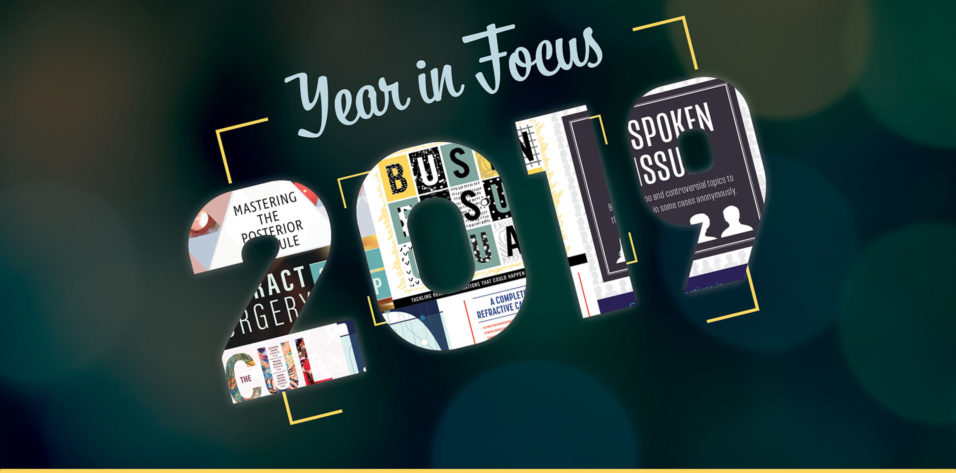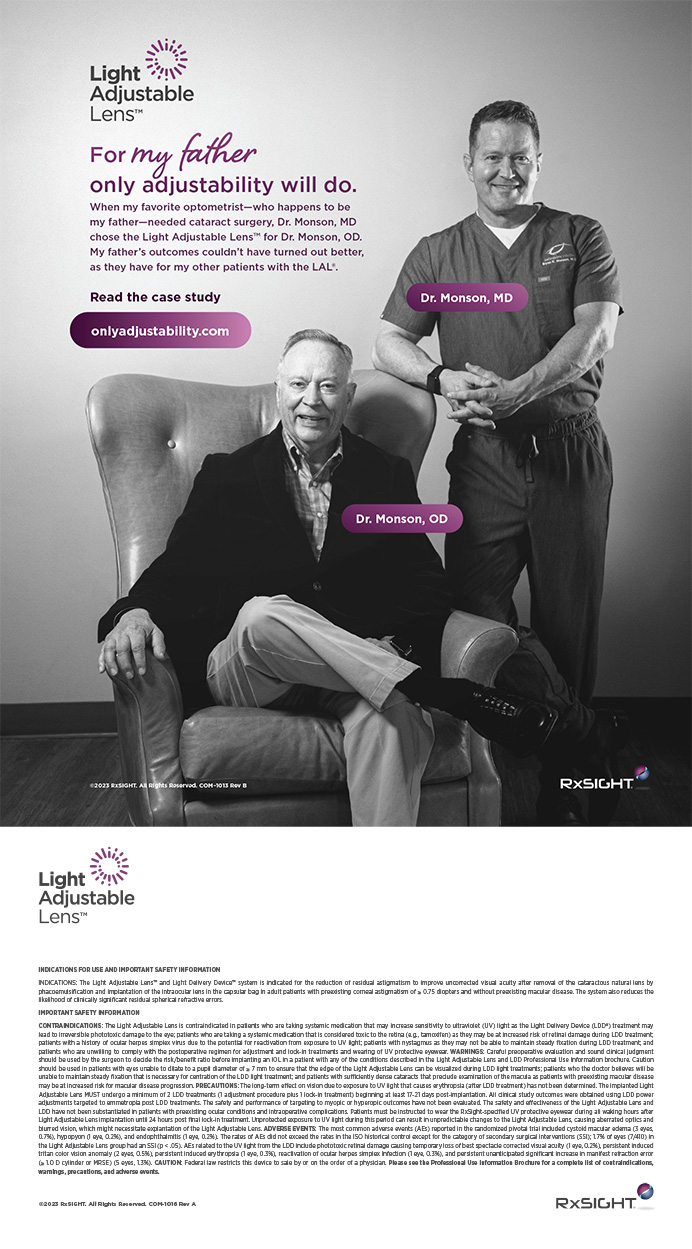What are the tops in technology that ophthalmology has seen in 2019?

Lisa Brothers Arbisser, MD
The Femto LDV Z8 (Ziemer Ophthalmic Systems) gaining FDA approval for hyaloid sparing posterior capsulotomy was the top development in my book. The laser can be moved in and out of the OR to preserve a sterile environment for the entire procedure. It has always been within our power, with the use of current technology and manual technique, to eliminate secondary cataract for all ages while preserving the hyaloid and providing the best quality of vision with posterior optic capture, but this gives us an automated alternative. Additionally, now that it is finally available in the United States, I am hopeful that the PanOptix IOL (Alcon) will be a panacea, though I believe something other than diffractive optics remains the holy grail.

Shamik Bafna, MD
The commercial launch of the Light Adjustable Lens (RxLAL, RxSight) was a notable advance. This IOL allows us to personalize a patient’s results by fine-tuning the level of monovision the patient wishes to achieve. Its customizability provides the most accurate results of any IOL in eyes that have previously undergone refractive surgery. Another significant event was the first US approval of a trifocal IOL; in our early experience, the PanOptix trifocal IOL provides excellent distance, intermediate, and near vision.

Detlev R.H. Breyer, MD
Several notable technology innovations were introduced this year: the IntelliAxis-L (Lensar), a guidance system for toric IOL orientation; the optimization of energy settings for the VisuMax femtosecond laser (Carl Zeiss Meditec) for SMILE surgery; a new violet-light–filtering, hydrophobic, segmental refractive extended depth of focus (EDOF) IOL in a one-piece C-loop design (Acunex Vario AN6V, Teleon Surgical); a new EDOF trifocal IOL with correction of chromatic aberration (FineVision Triumf POD L GF, PhysIOL); and several new IOLs designed on the principle that spherical aberration can enhance depth of field (Tecnis Eyhance, Johnson & Johnson Vision; Vivity DFT015, Alcon; xact Mono-EDoF, Santen). These innovations will assist surgeons in perfecting surgical workflow, reducing sources of error, optimizing refractive outcomes with minimally invasive technology, reducing side effects and complication rates, and raising patients’ levels of comfort and trust.

Arthur B. Cummings, MB ChB, FCS(SA), MMed(Ophth), FRCS(Edin)
The ultrafast Matrix femtosecond laser (KeraNova) has the potential to change cataract surgery by eliminating ultrasound use in most cases. Also, the Visual Behavior Monitor (VBM; Vivior), which monitors patients’ visual behavior to help select the best presbyopia-correcting IOL design, will help to improve patient flow and make IOL design decisions based on objective data.

Uday Devgan, MD, FACS, FRCS
The PanOptix trifocal IOL is a big step up from bifocal IOLs. Another game-changer is a self-calibrating ocular biometer, manufactured by Advanced Euclidean Solutions/IOLcalc.com, that will allow users to automatically hone IOL calculations.

Steven J. Dell, MD
The introductions of the RxLAL and the PanOptix trifocal IOL to the US market will complement our existing EDOF and multifocal IOL options, which will allow even more patients to achieve greater spectacle independence and improve patient satisfaction.
What are the tops in technology that ophthalmology has seen in 2019?

Kendall E. Donaldson, MD, MS
Significant developments in 2019 have included advancements in 3D imaging systems for the OR, such as the Ngenuity 3D Visualization System (Alcon); FDA approval of the PanOptix trifocal IOL; and further progress with refractive indexing techniques for the cornea and the lens, specifically (1) laser-induced refractive index change, under development by Clerio Vision, to noninvasively alter the refractive properties of the human cornea, and (2) femtosecond laser adjustment of implanted IOLs, under development by Perfect Lens.

John A. Hovanesian, MD
The PanOptix trifocal IOL is a game-changing implant. It is the first premium IOL that allows us to have a very simple conversation with cataract patients about what we’re offering: clear vision at all distances in both eyes. Glare and halos—so far—seem to be minimal and accepted by patients. Additionally, two products, dexamethasone intraocular suspension 9% (Dexycu, EyePoint Pharmaceuticals) and dexamethasone ophthalmic insert 0.4 mg (Dextenza, Ocular Therapeutix), will help us to eliminate postoperative drops. Lastly, the web-based software of Veracity Surgical (Carl Zeiss Meditec) simplifies and saves time in surgery planning.

Aylin Kılıç, MD
I have been impressed by the Anterion swept-source anterior segment OCT (Heidelberg Engineering), by the Femto LDV Z8 solid-state laser, and by the VBM. This last device allows us to determine visual needs to fit the patient’s lifestyle. (Editor’s note: For more information on the VBM, see Dr. Kiliç’s contribution to “Best Pearls of 2019”.)

Björn Johansson, MD, PhD, FEBO
The 3D heads-up microscopy of the Artevo 800 digital microscope (Carl Zeiss Meditec), unveiled at the Congress of the ESCRS in Paris, and the Ngenuity are interesting developments ergonomically as well as with respect to instruction, education, and training. Working in an academic hospital with the responsibility of teaching and training doctors and nurses at all stages of education, and observing the great need for recruiting new nurses and doctors to the field, I appreciate and have made use of this technological advance in a few operations to date. The recent upgrade of our OR microscopes makes it difficult to finance an immediate transition to 3D screen microscopy, but a 3D heads-up microscope is certainly on my wish list for future purchase.

Cynthia Matossian, MD, FACS
My picks are the availability of technologies for more precise intraoperative toric IOL alignment, including IntelliAxis-L, Verion (Alcon), and Callisto eye (Carl Zeiss Meditec), and the new postoperative steroid drug delivery options. Both Dexycu and Dextenza allow us to decrease the postoperative drop burden for patients while decreasing the number of callbacks we get from pharmacies and patients about preoperative medical regimens. I love taking steroid drop compliance out of the equation by delivering the medication at the conclusion of cataract surgery with either of these products.

Jodhbir S. Mehta, BSc (Hons), MBBS, PhD, FRCOphth, FRCS(Ed), FAMS
Out of a large field of great new technology, my experience with the IC-8 small-aperture IOL (AcuFocus) for post-LASIK patients has been fantastic. It gives patients with high astigmatism an option to gain intermediate and near vision. In combination with a monofocal in the contralateral eye, I mainly use the IC-8 in patients—especially post-LASIK patients—who are unable to have trifocals.

William J. Lahners, MD, FACS
My favorites are the iStent inject (Glaukos) and the XpandNT Iris Speculum (Diamatrix). The iStent inject has made the delivery of microinvasive glaucoma surgery (MIGS) achievable for surgeons of all skill and experience levels. I do not miss performing combined phacotrabeculectomy, but I love the new iStent delivery system. It is actually fun to inject these little glaucoma helpers into the trabecular meshwork, and the safety profile of the device is excellent. The XpandNT is my go-to device for pupil expansion. It is easy to insert, provides a nice physiologic pupil, and is easy to remove. I do almost exclusively supracapsular phacoemulsification, and this device enlarges the pupil but does not obstruct the prolapse of the nucleus into the anterior chamber.

Cathleen M. McCabe, MD
Far and away, the FDA approval of the PanOptix trifocal IOL has been the biggest game-changer. It has simplified discussion of advanced technology lens choices in patients with healthy eyes undergoing cataract surgery or refractive lens exchange by allowing surgeons to more predictably and consistently deliver a full range of spectacle-independent vision postoperatively. Other notable new technologies include the two new depot dexamethasone options, intracameral (Dexycu) or intracanalicular (Dextenza), that improve treatment of postoperative inflammation in cataract surgery. These are especially important in patients with decreased ability to comply with drops after surgery because of cost, physical difficulty instilling the drops, or memory issues, and for patients at elevated risk for postoperative inflammation (eg, with history of uveitis, cystoid macular edema, or diabetic macular edema).

Michael Patterson, DO
The combination of the IOLMaster 700 (Carl Zeiss Meditec) and Callisto eye has changed the way I do surgery. The Hydrus Microstent (Ivantis) is a great option for MIGS. Data for the PanOptix trifocal are too young to say definitively, but early results look great.

P. Dee G. Stephenson, MD
The PanOptix IOL and the new dexamethasone delivery options will improve patients’ outcomes and experiences. Insertion of the intracanalicular Dextenza insert in an office setting will improve the patient experience in cataract surgery, decrease the number of drops patients require postoperatively, and empower them with the newest technology.

Julian D. Stevens, MRCP, FRCS, FRCOphth
The capsulotomy-fixated Femtis IOL (Oculentis) is an important advance because it provides great centration and helps to ensure accurate biometry.

Karl G. Stonecipher, MD
The use of artificial intelligence (AI) and deep learning in ophthalmology is beginning to take shape as we are producing data sets approaching the 200,000 level. Meanwhile, IOLs continue to improve, and lens-shaping technology such as the RxLAL will be important. We are pretty good cataract and refractive surgeons with regard to patient satisfaction, but our cataract outcomes are nowhere near 100% regarding IOL predictions versus results. The LASIK-like results with the RxLAL are game-changing, with increasing percentages of 20/16, 20/12, and 20/10 outcomes reducing the need for enhancements.

Richard Tipperman, MD
I’m very excited about femtosecond laser adjustment of implanted IOLs, as is being developed by Perfect Lens with its refractive index shaping technology. My early experience with the PanOptix trifocal also leads me to believe that this IOL is significantly better than previous multifocal technologies.

Paolo Vinciguerra, MD
One of the most important advances of 2019 is the introduction of the Corvis Biomechanical Index Laser Vision Correction (CBI-LVC) module for the Corvis ST (Oculus Optikgeräte), which provides comprehensive biomechanical screening and analysis of the cornea as well as keratoconus detection. The CBI-LVC allows clinicians to detect early ectasia and aids in clinical decision making for retreatments after LASIK or CXL. The software displays the patient’s results against normative values.

William B. Trattler, MD
The PanOptix trifocal IOL and the RxLAL are two exciting technologies for our patients. The ability to customize refractive error postoperatively provides patients with more flexibility in determining what works best for them following cataract surgery or refractive lens exchange. Refractive cataract surgery continues to grow as patients’ experiences have improved and more patients are now asking for reduced spectacle dependence postoperatively.
With Regard to Ophthalmology Technology, What Are You most looking forward to seeing in 2020?

Arthur B. Cummings, MB ChB, FCS(SA), MMed(Ophth), FRCS(Edin)
I look forward to using the Matrix femtosecond laser in the clinic. Clinical trials are scheduled to commence in 2020.

Kendall E. Donaldson, MD, MS
Technology that allows us to adjust postoperative refractive results will hold great promise.

Björn Johansson, MD, PhD, FEBO
A presbyopia-correcting IOL with no optical disadvantages compared with monofocal aspheric IOLs is still to come.

John A. Hovanesian, MD
I am interested in seeing clinical results with the RxLAL.

Cynthia Matossian, MD, FACS
FDA approval for an intracameral antibiotic would be desirable. Then we will have an FDA-approved steroid and antibiotic to use at the conclusion of surgery. Patients will be happy with needing only to use an NSAID once daily postoperatively.

Jodhbir S. Mehta, BSc (Hons), MBBS, PhD, FRCOphth, FRCS(Ed), FAMS
I am interested in development of regenerative therapy in Fuchs endothelial corneal dystrophy. The use of topical medication to regenerate corneal endothelial cells is a growing area in corneal cell biology. The use of AI in refractive surgery to optimize outcomes is also something we will see more of.

Uday Devgan, MD, FACS, FRCS
More IOL choices are always welcome.

Aylin Kılıç, MD
I look forward to the next generation of presbyopia-correcting IOLs.

Steven J. Dell, MD
I’m interested in the new models of EDOF IOLs that are on the way. I would also like to see improvement in the rotational stability of toric IOLs.

Lisa Brothers Arbisser, MD
A way to preoperatively evaluate outflow channels for trabecular bypass MIGS and approval for standalone trabecular bypass technologies would be welcome. Also, I am hopeful to see progress in the femtosecond laser refractive index shaping of implants (Perfect Lens) and laser-induced refractive index change of corneas (Clerio Vision).

Shamik Bafna, MD
I look forward to US approval of the IC-8 IOL and introduction of another supraciliary MIGS device (iStent Supra Micro-Bypass Stent, Glaukos).

Detlev R.H. Breyer, MD
I hope to see introduction of a next-generation VisuMax laser for SMILE. I also look forward to research results in diffractive blended vision, iontophoresis CXL, Presbyond Laser Blended Vision (Carl Zeiss Meditec), and new EDOF and spherical IOLs.

William J. Lahners, MD, FACS
I would like to see the RxLAL in the marketplace, as I believe it has great potential to reduce the incidence of enhancement surgeries.

P. Dee G. Stephenson, MD
I look forward to new IOL materials, more preloaded IOLs, and software updates for the Cassini topographer (Cassini Technologies) and the Artevo 800 microscope. Digitalization and better ergonomics for surgeons are key trends that will shape our ORs in the near future. To provide better outcomes for our patients, we need better preoperative data that can then be transferred into the OR through overlays.
Surgeons understand the important role that ergonomics plays in our careers, evidenced by the trend toward 3D heads-up surgery in recent years. As a user of the Lumera microscope (Carl Zeiss Meditec) for a number of years, I was eager to see the company’s answer to the 3D trend. I had the opportunity to see the Artevo 800 before its full commercial launch, which will happen in 2020. The fully digital Artevo features stunning 4K 3D visualization, which does not compromise on the legendary optics I’ve come to know from a Zeiss microscope. Viewing via the heads-up display, I immediately noticed the amazing 4K image quality, improved depth of field, and reduced light intensity. The company has engineered the electronics inside the microscope, cameras, and monitors so that there is no noticeable lag, which was the main reason 3D visualization has been slow to be adopted. Another key feature is that the oculars can remain attached to the microscope.

Julian D. Stevens, MRCP, FRCS, FRCOphth
I look forward to the release of the EVO+ Visian ICL EDOF phakic IOL (STAAR Surgical).

Karl G. Stonecipher, MD
I would love to see an all-in-one diagnostic instrument, one that can screen for all the main data points for refractive surgery and refractive cataract surgery—refraction, pachymetry, IOP, biometry, topography, tomography—and also perform simple postoperative follow-ups. With such a system all in one box, we could seamlessly collect 3- or 6-month data and improve our nomograms and A-constants without having to jump through so many data entry points.

Paolo Vinciguerra, MD
I look forward to the release of minimally invasive lenticule extraction with the Schwind Atos femtosecond laser (Schwind eye-tech-solutions). SmartSight is Schwind’s version of SMILE.

Cathleen M. McCabe, MD
I hope to see additional advanced technology lens choices that improve patient satisfaction by decreasing unwanted visual disturbances. I also look forward to seeing better biometers that improve predictability of IOL power, more integration of heads-up operating systems with digital guidance and intraoperative imaging, more efficient and novel phacoemulsification technology, presbyopia-correcting eyedrops, and depot glaucoma pharmaceutical treatments.

Michael Patterson, DO
The iDose travoprost intraocular implant delivery system (Glaukos) and biodegradable bimatoprost sustained-release implant (Bimatoprost SR, Allergan) may both reach the market in 2020.

Richard Tipperman, MD
It is exciting to know that work will continue on the use of AI in IOL power calculations.

William B. Trattler, MD
I am eagerly awaiting pharmaceuticals for the treatment of presbyopia. Presbyopia is a huge challenge for patients, and I hope these technologies will become available and make a significant impact on our patients’ lives.

Lisa Brothers Arbisser, MD
The large-scale effort to demonstrate the value and safety of intracameral moxifloxacin for prevention of postcataract surgery endophthalmitis was important.1 Every surgeon should adopt this as routine, as I did in 2007. Further, the results of the HORIZON trial showed that the Hydrus Microstent is sufficiently safe and efficacious to be considered for use in every appropriate glaucoma patient having cataract surgery.2
One important clinical paper presentation is Lee and Chang’s “Rotational stability of toric multifocal and monofocal IOLs,” presented at an AAO 2019 free paper session.3 This important work is causing a critical lens design change by industry to improve lens stability.
1. Haripriya A, Chang DF, Ravindran RD. Endophthalmitis reduction with intracameral moxifloxacin in eyes with and without surgical complications: Results from 2 million consecutive cataract surgeries. J Cataract Refract Surg. 2019;45(9):1226-1233.
2. Jones J, Koch DD, Vold S, et al; HORIZON US investigators. Results from the United States cohort of the HORIZON trial of a Schlemm canal microstent to reduce intraocular pressure in primary open-angle glaucoma. J Cataract Refract Surg. 2019;45(9):1305-1315.
3. Chang DF, Lee B. Rotational stability of toric multifocal and monofocal IOLs. Paper presented at: the 2019 AAO annual meeting; October 12-15, 2019; San Francisco.

John A. Hovanesian, MD
Important introductions this year included the PanOptix trifocal IOL and the Veracity surgical planning software.

Cynthia Matossian, MD, FACS
The emergence of better IOL formulas such as the Barrett TK has been significant this year.

Kendall E. Donaldson, MD, MS
Notable breakthroughs this year included the US launch of the PanOptix trifocal IOL, improved imaging with the Ngenuity 3D visualization system, new options for dry eye including Cequa (cyclosporine ophthalmic solution 0.09%, Sun Ophthalmics), the approval of Flarex (fluorometholone acetate ophthalmic suspension 0.1%, Eyevance Pharmaceuticals) for the treatment of ocular surface disease, and a new anti-VEGF agent, Beovu (brolucizumab-dbll, Novartis).

Arthur B. Cummings, MB ChB, FCS(SA), MMed(Ophth), FRCS(Edin)
A study of the AcrySof Vivity Extended Vision IOL, shared at Alcon’s InnFocus Event in Paris at the 2019 ESCRS meeting, demonstrated that this is a true EDOF lens with no dysphotopsia and with side effects similar to those of a monofocal IOL. The introduction of InnovEyes LASIK for the WaveLight Refractive Suite (Alcon) promises to be the next step in personalized vision correction; it is the first commercially available ray-tracing profile for laser vision correction.

Jodhbir S. Mehta, BSc (Hons), MBBS, PhD, FRCOphth, FRCS(Ed), FAMS
I heard a great presentation by Michael W. Belin, MD, about the scientific validity of published literature.1 He spoke about how to examine the published literature properly and the fact that it can contain many mistakes. Dr. Belin’s presentation really calls our entire review process into question and explores how it could be improved.
1. Belin MW. Peer reviewed or poorly reviewed: Critique of commonly used methods. Paper presented at: the Annual Conference of Indian Society of Cornea & Keratorefractive Surgeons. August 3-4, 2019; New Delhi, India.

William J. Lahners, MD, FACS
My favorite presentation this year was given by Scott M. MacRae, MD, on laser-induced refractive index change in humans.1 In this work, investigators are using a low-power 405-nm laser to alter collagen fibril density in the cornea, thus changing its refractive index. This technique may offer a noninvasive way to correct all forms of refractive error in both phakic and pseudophakic eyes. I am looking forward to more data on this technology.
1. MacRae SM. Laser induced refractive index correction in humans. Paper presented at: the ASCRS/ASOA Annual Meeting; May 3-7, 2019, San Diego.
What do you consider to be the best scientific breakthroughs and achievements, including any specific peer-reviewed papers or talks given at congresses?

Cathleen M. McCabe, MD
Three-year outcomes for the HORIZON trial, comparing implantation of the Hydrus Microstent combined with cataract surgery to phacoemulsification alone, were presented at the 2019 AAO meeting by Gus Gazzard, MBBChir, MA, MD, FRCOphth, Director of the Glaucoma Service at Moorfields Eye Hospital.1 The data confirmed that significant IOP and medication reduction persisted to 3 years in patients with mild to moderate primary open angle glaucoma with the combined procedure. Of patients on one glaucoma drop preoperatively, 81% remained medication-free, compared with 48% in the phacoemulsification-only arm (P > .001). The HORIZON trial was the first to show that the incidence of secondary glaucoma procedures, such as trabeculectomy or tube shunts, was significantly less frequent in the Hydrus arm compared to the phacoemulsification arm after 3 years of follow-up. We know long-term medication adherence is a challenge for patients, so it’s possible that reducing dependence on medications for IOP control could be a factor in reducing the need for later surgery.
1. Gazzard G. IOP-lowering effect of Hydrus Microstent implantation combined with cataract surgery in moderate to advanced glaucoma. Paper presented at: the 2019 AAO annual meeting; October 12-15, 2019; San Francisco.

P. Dee G. Stephenson, MD
The multicenter study of Dextenza, the sustained-release intracanalicular dexamethasone insert, was of notable interest.1
1. Tyson SL, Bafna S, Gira JP, et al; Dextenza Study Group. Multicenter randomized phase 3 study of a sustained-release intracanalicular dexamethasone insert for treatment of ocular inflammation and pain after cataract surgery. J Cataract Refract Surg. 2019;45(2):204-212

Julian D. Stevens, MRCP, FRCS, FRCOphth
The introduction of AI in ophthalmology is a significant development. We can hope to see automated interpretation of retinal OCT and AI assistance in biometry, to name a couple.

Richard Tipperman, MD
I believe that femtosecond laser adjustment of implanted IOLs will be the biggest game-changer for cataract surgery. It will allow patients to trial monovision and even multifocality postoperatively.

Karl G. Stonecipher, MD
I enjoyed the paper by Durrie and colleagues showing that the number of eyes with 20/10 UCVA increased from 3 months to 1 year after topography-guided LASIK.1 The AI discussion session at ESCRS was pretty special, and Dan Z. Reinstein, MD, MA(Cantab), FRCSC, DABO, FRCOphth, FEBO, moderated a great course at the ESCRS in which speakers presented complex refractive surgery patients and a panel discussed how to help these complex patients and what the presenters did to make the patient better.
1. Durrie D, Stulting RD, Potvin R, Petznick A. More eyes with 20/10 distance visual acuity at 12 months versus 3 months in a topography-guided excimer laser trial: Possible contributing factors. J Cataract Refract Surg. 2019;45(5):595-600.

Paolo Vinciguerra, MD
The new monofocal Tecnis Synergy IOL (Johnson & Johnson Vision) and the EDOF Vivity IOL are significant breakthroughs.




